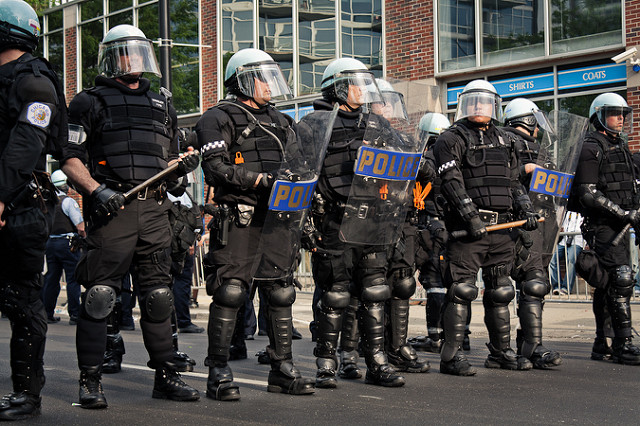
Some states are using regulatory approaches to ensure the accountability of law enforcement officials.
As the media continues to report on deadly interactions between police and the public, the need for new approaches to regulating police use of force could not be more apparent. The International Association of Chiefs of Police defines use of force as the “amount of effort required by police to compel compliance from an unwilling subject.” This definition seems straightforward until force either becomes unnecessary—which is when there is no justification for force—or excessive, which is when police use more force than necessary. These two issues often arise when investigating the myriad officer-involved deaths of unarmed citizens and the mentally ill.
States have their own discretion in defining use of force, which includes when and how force should be used. For example, many states allow the use of deadly force by an officer during an arrest. The question then, is how can we regulate this privilege to ensure accountability from officials who serve and protect the public? In this essay, I will attempt to answer that question by examining approaches to regulating police force in jurisdictions across the country, with a particular focus on Ohio.
The national trend in responding to this question involves new use-of-force standards, specialized training, and legislation. According to a report by the National Conference of State Legislatures (NCSL), nine states have enacted legislation that increase transparency surrounding investigations of officer-involved deaths and abuses of force. Illinois, Utah, and Wisconsin require personnel who investigate use-of-force cases to work in a different department than the officer who is under review. Continuing this trend, several more states—including California, Oregon, and North Carolina—require data collection on all incidents involving deadly force by police officers. NCSL also reported that at least 27 states have laws that require officers to receive training on interacting with citizens who have behavioral disorders, mental health, and substance use issues.
Litigation or consent decrees—which are negotiated agreements between a jurisdiction and the U.S. Department of Justice that entail policing reforms—have compelled police departments in other jurisdictions to address racial bias, eliminate patterns of excessive force, and increase civilian oversight of police-community relations. For example, consent decrees in Baltimore, Newark, New Jersey, and Ferguson, Missouri require these cities to adopt de-escalation and implicit bias awareness training for their officers, as well as accountability measures. These are some of the more recent consent decrees from the latter part of 2016 and early 2017. The underlying themes of consent decrees can vary, with some focusing on police-community relations, while other consent decrees emphasize reforms to jurisdictions’ criminal codes.
Before these nationwide trends emerged, Ohio, like most states, had failed to address the issue of excessive police force. However, in 2001, Cincinnati experienced a three-day riot sparked by the killing of civilian Timothy Thomas by a Cincinnati police officer. During this time, tremendous distrust existed between police and the community, which created a polarizing barrier of “us against them.” Citizens’ complaints of officer misconduct and racial profiling were often ignored because no one took the time to further investigate these accusations. This lack of investigation eroded police-community relations and led to the civil unrest surrounding Thomas’s death.
Prior to Thomas’s death, groups—including the American Civil Liberties Union—had filed a lawsuit challenging the standards and practice of policing in Cincinnati. In 2002, this lawsuit was settled through a Collaborative Agreement with the city of Cincinnati. As a result of this agreement, Cincinnati became the first city in Ohio to address police-community relations from a holistic viewpoint by implementing community-based policing and creating an independent entity known as the Citizens Complaint Authority (CCA). The CCA was established to promote bias-free policing, cultural competency among police, de-escalation training, and to prepare officers to interact with those who are mentally ill.
As part of its mission, the CCA is tasked with investigating citizen complaints involving police, including reports of police misconduct and discrimination, death in police custody, and excessive police force. Following its investigations, the CCA makes policy recommendations to the Cincinnati Police Department (CPD). To ensure its investigations are valid, the CCA reviews data on officer stops of civilians, which capture the nature of the stop, demographics of the persons involved, how long they are detained for, whether a search was involved, and other pertinent information.
With a system now in place that tracks complaints against officers and their conduct, management can review an officer’s behavior and provide constructive guidance before a more serious incident occurs. Prior to the CCA’s inception, officers were seldom questioned or disciplined for minor infractions, such as discourtesy.
Cincinnati also implemented policies that emphasize de-escalation and active listening in officer training. Trainees participate in active role-playing scenarios to learn how to manage a multitude of high-stakes situations. CPD also requires officer training for encounters with those who are mentally ill, and has a Mental Health Response Team, which consists of officers who are specifically trained to be first responders to incidents that involve mentally ill individuals.
More recently, the Cincinnati Branch of the National Association for the Advancement of Colored People (NAACP) passed a resolution calling for the national NAACP to advocate for state legislation that would require officers to receive the same number of hours of de-escalation training that they have in firearms training. A survey conducted by the Police Executive Research Forum found that the average officer receives 58 hours of firearms training, 49 hours of defensive tactical training, and only eight hours of de-escalation training. The resolution also called for legislative language that would specifically outline when deadly force is allowed.
As we formulate a solution to this issue, no single approach should be endorsed over another. As time passes, a better picture of what is the most effective way of managing use of force will emerge. However, to sufficiently examine the impact of regulations and policies, data collection on officer conduct should be a mandatory requirement for all police agencies, since it provides insight into potential problems in policing and reveals areas for improvement.
In the case of Cincinnati, initiatives like the CCA were initially successful, but due to budget cuts and short staffing, the CCA’s authority has been undermined. Many still believe that the CPD is racially biased. If citizen complaint boards, consent decrees, and legislation are effective ways to address police use of force, then adequate funding, data collection, and other resources must be used to fully support these approaches. It is incumbent on state and local governments to ensure that they embrace and provide sufficient funding for these types of initiatives.
This essay is part of a fifteen-part series, Regulating Police Use of Force.




